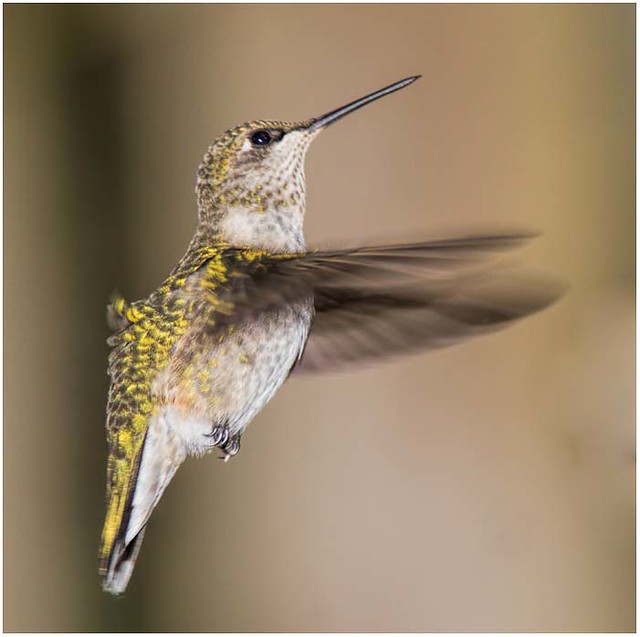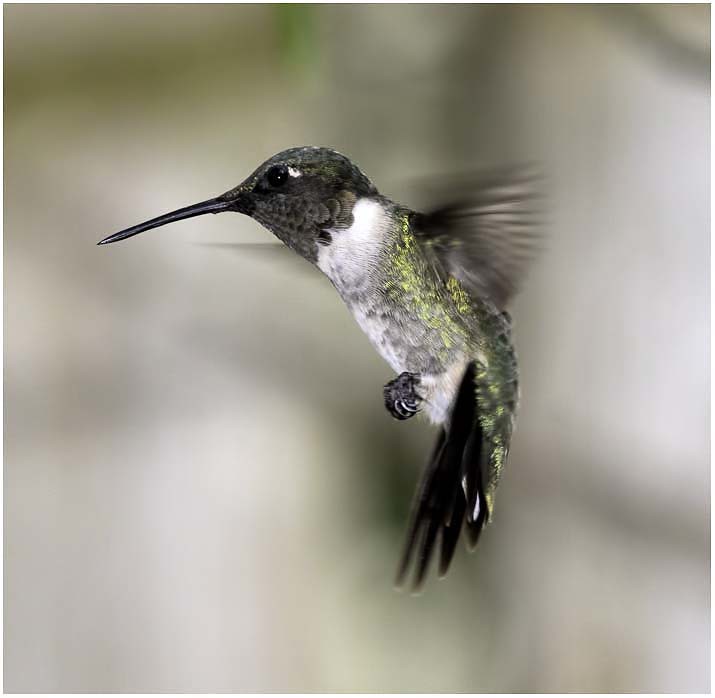The males are usually pretty shy, but this guy didn't mind me sitting only a few feet away with a flash-mounted DSLR:
Male Ruby-throated hummingbird by tombarry975, on Flickr
Results 1 to 10 of 10
Thread: Male ruby-throated hummer
-
31st August 2015, 04:10 PM #1

- Join Date
- Jan 2010
- Location
- Central Texas, USA
- Posts
- 1,165
Male ruby-throated hummer
-
31st August 2015, 05:01 PM #2

- Join Date
- May 2011
- Location
- SE Michigan
- Posts
- 4,511
- Real Name
- wm c boyer
Re: Male ruby-throated hummer
I would have thought that the flash would have done more to freeze the wing action...
what was your SS?
-
31st August 2015, 06:37 PM #3

- Join Date
- Jan 2010
- Location
- Central Texas, USA
- Posts
- 1,165
-
31st August 2015, 07:04 PM #4
Re: Male ruby-throated hummer
Nice effort.
-
31st August 2015, 08:04 PM #5

- Join Date
- Dec 2013
- Location
- Turkey
- Posts
- 12,779
- Real Name
- Binnur
Re: Male ruby-throated hummer
The head looks sharp and clear enough, very nice image

-
31st August 2015, 09:17 PM #6
Re: Male ruby-throated hummer
Nicely captured Tom. It's good to see the recent interest here in capturing these difficult subjects.
I suppose the answer here is in knowing the speed of movement you are trying to freeze.
Simple really if your know the linear speed of a point on a wing tip travelling through the figure of eight path it takes repeated around fifty times per second. If we then take account of the focal length, distance from camera and sensor size I think we would get the answer
-
1st September 2015, 01:38 AM #7
-
1st September 2015, 10:41 AM #8

- Join Date
- Jan 2010
- Location
- Central Texas, USA
- Posts
- 1,165
Re: Male ruby-throated hummer
I really think catching the wings clearly is sometimes a matter of whether they were near a full-forward or full-back position when the flash and/or shutter fired. I've seen incredible stop-motion hummer photos where the photographer sets up 3 or more remote flashes close to a feeder and adjusted manually to as low as 1/34th power to get flash duration of /20,000th sec. I don't have the patience for that. I think some wing blur adds to the verisimilitude. Here's a female shot using manual flash at full power with a shutter speed at 1/640th sec. Similar equipment, except I used the EF 2X converter on the EF 200mm f2.8L rather than the 1.4X converter. Click on it to see it on the lightbox:

Hovering by tombarry975, on Flickr Last edited by Tom Barry; 1st September 2015 at 02:05 PM.
-
1st September 2015, 08:34 PM #9
Re: Male ruby-throated hummer
Another great capture Tom.
My comment above was an attempt at humour because I suspect someone somewhere has run the figures and come up with an answer to the maximum linear speed (which I assume will occur around mid way between for and aft positions) of the wing tips from which shutter or flash speed required to freeze it could be calculated.
I suspect the guys who undertook this experiment http://www.sciencealert.com/watch-me...-unique-flight know the answer
I too have seen the frozen pictures taken with multi flash set up but whilst technically clever prefer seeing some movement blur as in the above images.
-
2nd September 2015, 01:03 AM #10

- Join Date
- Jan 2010
- Location
- Central Texas, USA
- Posts
- 1,165
Re: Male ruby-throated hummer
I rather thought you were having a bit of fun, but couldn't be absolutely sure, so I played it down the middle. Thanks for the comments, etc., all.

 Helpful Posts:
Helpful Posts: 

 Reply With Quote
Reply With Quote
